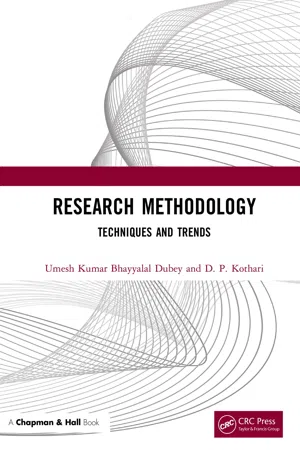Social Sciences
Questionnaire
A questionnaire is a research tool used to gather information from individuals by asking them a series of questions. It is a structured method of data collection that can be used to gather both qualitative and quantitative data. Questionnaires are commonly used in social sciences to study attitudes, behaviors, and characteristics of a population.
Written by Perlego with AI-assistance
Related key terms
Related key terms
1 of 4
Related key terms
1 of 3
12 Key excerpts on "Questionnaire"
- eBook - ePub
Research Methodology
Techniques and Trends
- Umesh Kumar B Dubey, D P Kothari(Authors)
- 2022(Publication Date)
- Chapman and Hall/CRC(Publisher)
9 QuestionnaireDOI: 10.1201/9781315167138-99.1 Introduction
A Questionnaire may include a series of questions to be answered by an individual or group, with the aim of obtaining relevant data on the topic of research. This could be self-administered or could be administered by an interviewer. Broadly survey questions can be classified as structured and unstructured. In research, both structured and unstructured Questionnaire are in use.9.2 Definition of Questionnaire Method
Questionnaire is a data collection instrument. The researchers for collecting data most commonly use this method. The researcher lists the questions to which he or she requires answers, in order to gather data on a particular research topic. The list of questions grouped in some order is either given personally, or mailed to the target population.9.3 Construction of Questionnaire
Caution must be taken in the selection of questions and variables, so that the researcher can receive accurate answers that he or she wants to explore. The purpose of this type of data-gathering technique is to obtain valid and reliable information so that smooth investigation can be conducted and hypothesis can be tested. A clear understanding of the problem under study is essential for the researcher. Hence, before finalizing the contents of the Questionnaire, he or she needs to review the related literature.The covering letter explains the identity of the researcher, objectives of the research, need for Questionnaire, tell the respondents what use will be made of the results and precisely what will happen to their answers, request the respondent for cooperation, explain the purpose of the Questionnaire, and ensure the confidentiality of respondent’s answers. This assurance will motivate the respondents to express their views freely. - eBook - ePub
- James P. Neelankavil(Author)
- 2015(Publication Date)
- Routledge(Publisher)
Questionnaires used in surveys tend to be more structured than those used in exploratory research techniques. A Questionnaire can be structured or unstructured. Structured Questionnaires contain a specific set of questions in a predetermined sequence asked of all respondents. This form of data gathering also tends to be direct, as each respondent is contacted separately and individually. Surveys using structured Questionnaires tend to be the most widely used technique for collecting detailed and specific information. In contrast, unstructured Questionnaires contain open-ended questions that respondents answer in their own words, and the question sequence may depend on subjects’ responses. Some Questionnaires may contain both structured and unstructured questions. Questions in a Questionnaire should be based on the information required by the objectives of the research. A Questionnaire is defined as a series of questions on a specific topic, based on specific information needs or research goals, that a respondent answers. Questionnaires are also referred to as instruments or interview forms. The role of a Questionnaire is to translate the research objective(s) into specific questions that are asked of respondents. Questionnaires serve as permanent records of the research. Therefore, if more information needs to be extracted in the future, Questionnaires may be reviewed or analyzed again. B ASIC R EQUIREMENTS OF A Q UESTIONNAIRE In developing a Questionnaire, researchers adhere to the following guidelines: • Be complete. Respondents do not volunteer information; therefore, each Questionnaire must be complete and include all relevant questions for which answers are sought. It is important that researchers develop questions on the basis of what they want to know. Researchers get only one chance with a given Questionnaire to obtain information from a given sample - eBook - ePub
Laboratory Psychology
A Beginner's Guide
- Julia Nunn(Author)
- 2018(Publication Date)
- Psychology Press(Publisher)
5Questionnaire design Ingrid SchoonAims
T he aim of this chapter is to introduce the reader to the major stages in Questionnaire design and to demonstrate how to choose and develop a Questionnaire for a research project. Areas covered include: functions of the Questionnaire, Questionnaire planning, modes of data collection, response format, question wording, layout of a Questionnaire, and the criteria used to evaluate the quality of a Questionnaire (reliability and validity).Introduction: The function of a Questionnaire
The Questionnaire is a widely used and well respected instrument in psychological research. The Questionnaire is basically a tool for data collection. The major advantages of the Questionnaire in comparison to other research tools, for example the experiment or the unstructured interview, are its obvious simplicity, its versatility, and its low cost as a method of data collection. No fancy or complicated apparatus is needed to administer a Questionnaire—paper and pencil will do. However, Questionnaires can also be administered via computer-assisted techniques. Or, in cases where one wants to reach a great number of people, or individuals who live in widely dispersed areas, one might consider using a postal Questionnaire. The mode of data collection (see later section) should depend on its appropriateness to the research question and the means and resources at your disposal.Questionnaires are used in large-scale surveys, such as the British Social Attitudes Survey (Jowell et al., 1993), as well as in smaller-scale projects, including psychology laboratory classes. Questionnaires are used to gather facts about individuals, such as their age, gender, level of education, status of employment, their eating habits, etc., or if one wants to assess a phenomenon that is not directly observable, or cannot be experimentally manipulated, for example loss of self-esteem in response to unemployment. The data collected from a well designed Questionnaire is commonly considered to be of good enough quality for generating or testing hypotheses (Cronbach, 1990; Oppenheim, 1992). Questionnaire construction furthermore is employed in the development of psychometric tests that are used for assessing personality characteristics, attitudes, abilities, or aptitudes. - eBook - ePub
Appraising and Using Social Research in the Human Services
An Introduction for Social Work and Health Professionals
- Michael Sheppard(Author)
- 2004(Publication Date)
- Jessica Kingsley Publishers(Publisher)
CHAPTER FOURQuestionnaire Design for Quantitative Research: Structured InstrumentsQuestionnaires are available for practitioners to use in their everyday life. We can use them to measure family functioning, parenting style, psychological well-being, and a host of other circumstances. Health visitors have increasingly, for example, used the Edinburgh scale to look at mothers’ psychological state in the post-birth period. The Assessment Framework pack, published by the government, for Children in Need and Their Families, contains a pack of Questionnaires, or instruments, that may potentially be used by practitioners. Various instruments have been used by psychiatric nurses to help their assessment of mental state and social functioning. The use of these is, as far as we can tell, variable, and there may at times be some reluctance to use them. Nevertheless, they remain a part of the armoury of social and health workers.For that reason alone, it is a good idea to consider Questionnaires and their development. However, Questionnaires also provide a crucial building block for quantitative research, and so need to be understood by practitioners who are in the business of making use of such research in their practice.Quantitative research is research that seeks to ascribe numbers to facets of social life. How many people suffer some form of mental illness in a particular area? What are the rates of petty crime? Do these vary by age, sex or ethnic group? And so on.At the heart of quantitative social research is the use of Questionnaires, or fully structured instruments, which can yield aggregates of numbers when analysed together. For example, we can know how many clients seeking social services support, or patients attending general practice, sought help with practical matters, compared with the number seeking advice, or medical help, or counselling, or some kind of resources, such as access to a day centre or residential home. We do this by asking them why they got in contact with social services or general practice, and give them a range of possible responses (this is not the only way of doing things – there are, for example, open questions – of which more later) from which they identify the one that is most accurate for them. Thus we could ask the questions Why did you get in contact with social services? or Why did you attend general practice? - eBook - ePub
Using Research Instruments
A Guide for Researchers
- Peter Birmingham, David Wilkinson(Authors)
- 2003(Publication Date)
- Routledge(Publisher)
We often require information on a range of subjects and to obtain that information we may be required to ask people questions. Questionnaires can be designed and used to collect vast quantities of data from a variety of respondents. They have a number of benefits over other forms of data collection: they are usually inexpensive to administer; very little training is needed to develop them; and they can be easily and quickly analysed once completed.An effective Questionnaire is one that enables the transmission of useful and accurate information or data from the respondent to the researcher. This is a complex process which involves presenting questions in a clear and unambiguous way so that the respondent may interpret them, articulate his or her response and transmit it effectively to the researcher. Once transmitted, the answers must be recorded, coded and analysed fairly so that they accurately reflect the respondents’ views.FIGURE 1.2 National Railway Museum question formTypes of Questionnaire
Essentially, there are three broad types of Questionnaire–the mail survey, the group-administered Questionnaire, and the household drop-off survey. The mail survey is, by far, the most common Questionnaire type. This instrument is addressed to respondents and delivered by mail, and can be an efficient way of collecting large amounts of data. The mail survey is, however, sometimes considered impersonal and can suffer from low response rates.The group-administered Questionnaire is a useful instrument for collecting data from a sample of respondents who can naturally be brought together for the purpose. For example, we have often used group-administered Questionnaires in our own research to collect data from students attending a lecture, teachers in a school and medical personnel in hospitals. This type of instrument allows each member of the group to complete his or her own Questionnaire and return it to the researcher on completion. Response rates using group-administered Questionnaires can be higher than those for mail surveys, as the group is often assembled specifically for the purpose of assisting with the research and the respondents feel personally involved with the work by being handed the Questionnaire by a member of the research team. - eBook - ePub
- Maree K, Maree K(Authors)
- 2020(Publication Date)
- Van Schaik Publishers(Publisher)
1959Surveys and the use of Questionnaires
Kobus Maree and Jacques PietersenOUTCOMES FOR THIS CHAPTER
After studying this chapter, you should be able to do the following:- Explain the meaning of the concepts “survey” and “survey design”
- Discuss and exemplify different data generation or construction methods
- Describe the advantages and disadvantages of different data-collection methods
- Explain different question types 196
9.1 INTRODUCTION
In this chapter we give attention to the many different ways in which surveys can be conducted and to the most widely used method of gathering information from people – the Questionnaire. (See Appendix E and Appendix G .)9.2 DEFINING A SURVEY
According to McMillan and Schumacher (2001) and Crowther, Smit and Herbst (1994), in survey research, researchers select samples of respondents before administering Questionnaires or conducting interviews to collect information about their attitudes, values, habits, ideas, demographics, feelings, opinions, perceptions, plans and beliefs. Whereas McMillan and Schumacher (2001: 602) define a survey research as “the assessment of the current status, opinions, beliefs, and attitudes by Questionnaires or interviews from a known population”, Cohen, Manion and Morrison (2001: 169) assert that surveys “set out to describe and to interpret what is”. Although surveys are usually conducted by means of Questionnaires, information can be obtained in a number of other ways, including interviews, telephone calls and observation.Two typical characteristics of surveys are the following:- Samples are usually big – from a few hundred to a few thousand.
- Many variables are measured and multiple hypotheses are tested.
9.3 SURVEY DESIGN
According to McMillan and Schumacher (2001) and Crowther et al. (1994), survey data are used to describe and explain the status of phenomena, to trace change and to draw comparisons. These authors maintain that the word “design” refers to the degree of control the researcher manages to exert over her or his survey environment. Ideally, researchers should aim for optimal control over the survey environment, for example in terms of when and at which intervals respondents will be surveyed, data-gathering techniques, sampling strategy (e.g. how many respondents will be included), the necessity1 of a pilot study2 - eBook - ePub
Research Methods for Leisure, Recreation and Tourism
Management, Marketing and Sustainability
- Ercan Sirakaya-Turk, Muzaffer Uysal, William Hammitt, Jerry Vaske, Ercan Sirakaya-Turk, Muzaffer Uysal, William Hammitt, Jerry Vaske(Authors)
- 2017(Publication Date)
- CAB International(Publisher)
2014 ), experts in survey design and data collection, a mixed mode is a more appropriate data method than any one single format. The idea is to have the maximum highest possible response rate from your subjects. The best way of doing this is to use all necessary means to get in touch with your sample subjects and entice them into completing and returning the Questionnaires. Some people prefer reading hard copies but may find it cumbersome to drop off the completed survey into a mailbox, while others may lack access to the technology platform or skills to respond using online platforms. We need to use all possible means, without breaking the bank, of course, to obtain high-quality data.The section will not discuss the strengths and weaknesses of each data collection method. Generic introductory research methods books that can be found in your school’s library contain much of this debate. Here, we would like to address one crucial topic: data collection using a survey instrument (a Questionnaire, a form). Survey instruments (Questionnaires) are standard forms that can be useful and be adapted easily to a variety of data collection circumstances. The basic principles surrounding Questionnaire design are valid whether you conduct a mail, online survey or modified interviews.Data collection, according to Rosnow and Rosenthal (1998 ), Salkind (2012 , 2017 ), and Dillman et al. (2014 ) consists of four steps: (i) developing an instrument or form that will be used to record information from your sample; (ii) coding the information to be obtained in a most efficient way; (iii) collecting the actual information (data); and (iv) entering the information into a database.Questionnaire design
How do we know what questions to ask? How many questions shall we ask? How do we ask the right questions? Is there any limit to the number of questions? These issues will drive the development of the survey instrument before any other design matters are addressed.Guideline #1: Do your prep work and let your study purpose and variables dictate the design.Recall the discussion in Chapter 1 about the dependent and independent variables and the issues outlined in the Club Ottomans-II case scenario. Your survey instrument needs to contain questions related to your dependent (DV) and independent variables (IVs) that are part of your research questions and hypotheses. Of course, depending upon how these variables are measured or operationalized, the length of your instrument will change. Again, recall the measurement issues discussed in Chapter 4 - eBook - ePub
- Brian Allison, Anne Hilton, Tim O'Sullivan, Alun Owen, Arthur Rothwell(Authors)
- 2016(Publication Date)
- Routledge(Publisher)
population.Passage contains an image
12 Planning and logistics of Questionnaire design
DOI: 10.4324/9781315041780-12Quantitative or qualitative?
If your aim is to express your findings in figures, then you are planning a quantitative study. If, on the other hand, you are simply exploring to see what factors are involved in order to gain an understanding of a topic, without needing to know how often these factors occur, then you are making a qualitative study.Qualitative research is sometimes sufficient to give all the information needed, eg in studying careers through a collection of case studies or in describing how a change was brought about in industrial relations, an interesting and convincing study might be made without any laborious numerical analysis.Frequently, however, qualitative research is done as a preliminary step towards quantitative data. For example, a qualitative Questionnaire could be used to identify important topics to provide the basis of a quantitative Questionnaire.Undoubtedly the great majority of Questionnaires are designed with quantitative analysis in mind, though most contain a few items for qualitative analysis. Qualitative research usually uses other methods of data collection, such as interviews and observation.Quantitative data are often gathered using items offering a choice of predetermined responses for easy analysis, whereas the nature of qualitative research prevents prediction of the categories into which the data can be placed for analysis. Thus qualitative data, while avoiding the complexities of statistical analysis, is much more time consuming to analyse.Activity 12.1Let's check whether you are clear as to the relative merits of quantitative and qualitative studies. (The solutions are on page 99.) - eBook - ePub
- Robert E Stevens, David L Loudon, Morris E Ruddick, Bruce Wrenn, Philip K Sherwood(Authors)
- 2012(Publication Date)
- Routledge(Publisher)
Chapter 6 Designing the Data-Gathering Instrument When we use the term “data-gathering instrument” we typically are referring to using a descriptive research design data-collection method. We do not think of collecting “data” per se in exploratory research (i.e., we are generating hypotheses, ideas, insights, clarifying concepts, prioritizing objectives for the next phase of research, etc.), and although we do generate data in causal research, we tend to think in terms of putting together an experimental design rather than designing a data-collection instrument. The quality of the information gathered is directly proportional to the quality of the instrument designed to collect the data. Consequently, it is extremely important that the most effective data-gathering instrument possible be constructed. As mentioned in Chapter 2, it is vital to anticipate the total information needs of the project so the data-gathering instrument can be designed in such a way that it will provide answers to the research questions. The instrument must also gather the data in a form that permits processing it using the analytical techniques selected. As a result of its importance, the data-gathering instrument is the “hinge” that holds the research project together and must be done well. GOALS OF A Questionnaire A Questionnaire is the main type of data-gathering instrument in descriptive research designs. A Questionnaire is defined in Webster’s New Collegiate Dictionary as “a set of questions for obtaining statistically useful or personal information from individuals.” Obviously, an effective Questionnaire is much more than that. Since poor Questionnaire design is a primary contributor to nonsampling errors, specifically response errors, the Questionnaire should be well designed. The questions should minimize the possibility that respondents will give inaccurate answers. The questions that are asked respondents are the basic essence of a research project - Yuksel Ekinci(Author)
- 2015(Publication Date)
- SAGE Publications Ltd(Publisher)
2 Understanding Research QuestionnairesIntroduction
If you intend to use the Questionnaire for your research, you should ensure that it provides the necessary information to encourage the right answers to your research problem. The purpose of this chapter is to illustrate the extent to which various types of Questionnaires could be compatible with different research approaches and research designs. This will enable you to assess whether the purpose of your study and the argument you intend to develop are compatible with the types of data you will need to collect. From this, you will be able to ascertain the type of Questionnaire you will need to use.Chapter 2 is structured around the research process, research design and key decisions required in the choice of questions and design of the Questionnaire. The research process is depicted and practical examples are used throughout this chapter. Table 2.1 illustrates an overview of the research process, research design and the types of Questionnaire that fit into this process.The research process, as illustrated in Table 2.1 , forms the building blocks to scientific research. Questionnaire design is influenced by decisions taken at various steps of this process and more specifically at the research design stage.The Research Process
The research process is a carefully planned, evolutionary journey that begins with a specific topic that produces a need for research. When you engage in a research project, you begin your journey with the purpose of finding answers to your research problem. This research problem is often described as a question that requires an answer. Your research journey will gradually progress and will depend on your research philosophy, adopted research approach and how you collect and analyse data. The research will conclude with remarks on your findings and, where appropriate, recommendations. The aim of your research is to discover the answer to your research problem, from which you must consider the theoretical and managerial implications of what has been revealed.- eBook - ePub
- Lars E. Lyberg, Paul P. Biemer, Martin Collins, Edith D. de Leeuw, Cathryn Dippo, Norbert Schwarz, Dennis Trewin, Lars E. Lyberg, Paul P. Biemer, Martin Collins, Edith de Leeuw, Cathryn Dippo, Norbert Schwarz, Dennis Trewin(Authors)
- 2012(Publication Date)
- Wiley-Interscience(Publisher)
SECTION A
Questionnaire Design
Passage contains an image
Chapter 1
Questionnaire Design: The Rocky Road from Concepts to Answers
Norbert SchwarzUniversity of Michigan, Ann Arbor1.1 INTRODUCTION
According to textbook knowledge, research is conducted to answer theoretical or applied questions that the investigators—or their clients or funding agencies—consider of interest. Moreover, the specifics of the research design are tailored to meet the theoretical or applied objectives. Depending on one’s research environment, these assumptions reflect a “trivial truism” (as one colleague put it) or the “lofty illusions of academic theoreticians” (as another colleague put it). This chapter, and the contributions to the section on “Questionnaire Design” address different aspects of the long and rocky road from conceptual issues to the answers provided by survey respondents. The first part of this chapter reviews key elements of survey design, which are elaborated upon in more detail in subsequent sections of this volume.1.2 ELEMENTS OF SURVEY DESIGN
Schuman and Kalton (1985) delineate and discuss the major components of a survey. Starting from a set of research objectives, researchers specify the population of interest and draw an appropriate sample. The research objectives further determine the concepts to be investigated, which need to be translated into appropriate questions. As Schuman and Kalton (1985, p. 640) observed, “Ideally, sampling design and question construction should proceed hand in hand, both guided by the problem to be investigated. When these stages are not well integrated—a rather common failing—one ends up with questions that do not fit part of the sample or with a sample that provides too few cases for a key analysis.” Note that neither the sample nor the specific question asked embodies the researcher’s primary interest. Rather, “investigators use one (sample, question) to make inferences about the other (population, concept), with the latter being what one is primarily interested in. Sampling populations and operationalizing concepts are each intended to allow us to go from the observed to the unobserved” (Schuman and Kalton, 1985, pp. 640-641). - eBook - ePub
- Gary Rassel, Suzanne Leland, Zachary Mohr, Elizabethann O'Sullivan(Authors)
- 2020(Publication Date)
- Routledge(Publisher)
The planning process brings critical actors together to decide what information they want, whether a survey is needed, and if it will yield the desired information. From the various discussions, the investigators should be able to identify a list of variables. With this list, they can develop measures and design an instrument. Finally, the contents of the Questionnaire are outlined, as in Example 7.7, to evaluate if all the proposed items are needed and if all needed items have been included. Once it is outlined, further feedback may be solicited from critical actors. Next, the Questionnaire should be reviewed by researchers and their colleagues. They should determine if the questions seem reliable: Are there any ambiguous items? Are the response choices appropriate? Is the information easily available to respondents? Writing questions takes time and effort. Survey researchers need a thick skin, because good Questionnaires are more likely to emerge if exposed to a lot of criticism and argument. Good Questionnaire design takes place among equals, with everyone’s comments getting consideration. In our experience, not only do participants act as equals, but they become intense and pointed in their comments. To illustrate the process of question writing, we have selected just one question from the DECIDE survey. Example 7.8 shows the changes that question underwent through various drafting sessions. Example 7.8 The Evolution of a Question Situation: Questionnaire on DECIDE training was designed to learn how trainees felt it affected their jobs. Stage 1 A group of three wrote a Questionnaire. The first Questionnaire had several questions on DECIDE’s effect and use on the job
Index pages curate the most relevant extracts from our library of academic textbooks. They’ve been created using an in-house natural language model (NLM), each adding context and meaning to key research topics.
Explore more topic indexes
Explore more topic indexes
1 of 6
Explore more topic indexes
1 of 4











